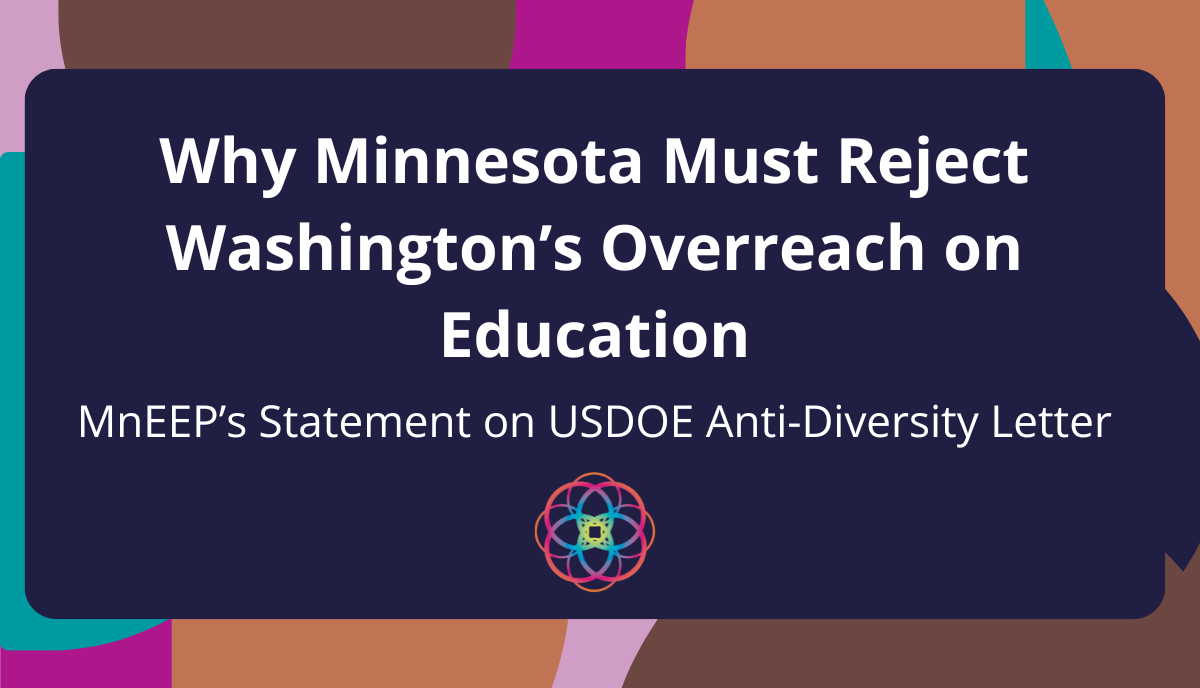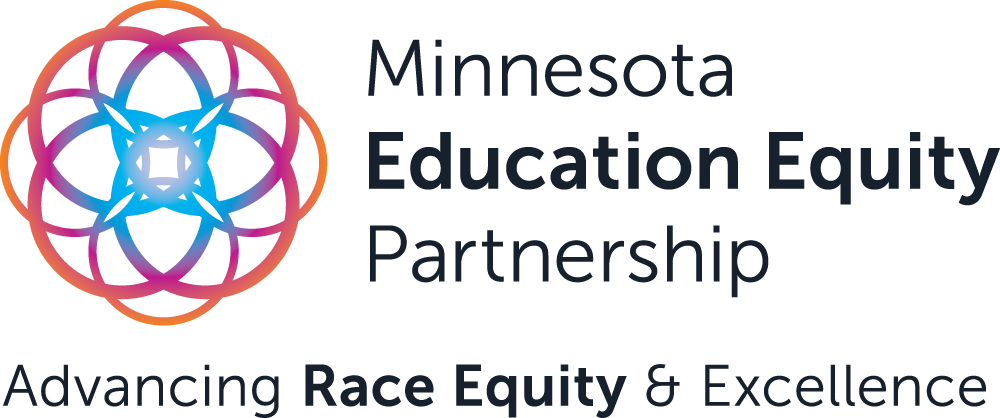
Why Minnesota Must Reject Washington’s Overreach on Education
MnEEP’s Statement on USDOE Anti-Diversity Letter
Washington should respect how Minnesota educates its students
The U.S. Department of Education’s (USDOE) latest “Dear Colleague” letter, sent to schools across the country this past weekend, is not a routine policy update—it is a direct assault on Minnesota’s values, laws, and commitment to racial equity and academic achievement for all students. Issued by the new White House administration, this directive declares all race-conscious student programming, resources, and financial aid illegal and threatens to withhold federal funds unless Minnesota abandons its successful, legally grounded approach to education and conforms to Washington’s ideological agenda.

This is not fairness—it is coercion. And Minnesota must reject this federal overreach outright.
The USDOE’s radical reinterpretation of federal law is both legally flawed and morally indefensible. It seeks to strong-arm Minnesota into dismantling sound, strategic investments that expand educational access—particularly for marginalized students who continue to face systemic barriers.
Minnesota must stand firm. Our education policies are not dictated by Washington bureaucrats; they are shaped by the people of Minnesota. Through our legislature, our Constitution, and our long-standing commitment to ensuring every student has the opportunity to succeed, we determine how best to serve our communities. We cannot allow an overreaching federal mandate to undermine that commitment.
Minnesota’s approach to education is lawful, effective, and smart
Minnesota is acting both morally and legally by recognizing the cultural, racial, geographic, and linguistic backgrounds of its residents and shaping education policies that align with their social and financial realities. A stronger, more prosperous Minnesota depends on ensuring every student has the opportunity to earn a high school diploma, vocational certificate, or college degree.
Minnesota law has long been clear in its commitment to building on human diversity and ensuring that all communities benefit from an inclusive approach to investing public resources.
For example, in 2015, Minnesota codified Minnesota College Attainment Goals into state statute, setting a clear target: by 2025, 70% of the state’s working-age population should have some form of post-secondary credential, whether that’s an automotive certificate, a vocational degree, or a medical doctorate. Decades of research confirm what Minnesotans have long understood, that higher education leads to better wages, lower unemployment, improved health outcomes, and a stronger economy for everyone.
To achieve this goal, Minnesota law recognizes that not all students have the same access to educational resources, support, and opportunities. That’s why state law requires tracking student outcomes by race, income, and other demographic factors to measure progress toward post-secondary attainment goals and identify the most effective strategies for enhancing student outcomes.
These proven strategies include multilingual learning services, mentorship from professionals who reflect students’ racial and cultural backgrounds, and teaching methods that affirm students’ identities while addressing racial bias, animus, and systemic barriers that continue to impact student success.
Minnesota did not arrive at this policy through bureaucratic decree. It was shaped through public hearings, constitutional review, and bipartisan support. This policy became law because it strengthens Minnesota’s economy and communities. Unlike the USDOE’s letter, crafted by political operatives in Washington with no stake in our state’s success, this policy was created by Minnesotans, for Minnesotans, to build a stronger future for all.
Education is Minnesota’s constitutional duty—not Washington’s
The federal government does not carry the legal and fiscal responsibility to ensure the existence of our schools and universities. That responsibility belongs to the State of Minnesota. Minnesota alone has the constitutional duty to fund and maintain its schools and universities, a responsibility that extends to our 579 school districts, including 340 regular districts and 161 charter schools, as well as our state college system and land-grant university.
Nowhere in the U.S. Constitution is there a mention of public education. It is not a federal duty, nor is there any constitutional requirement for Washington to control how schools operate.
Minnesota’s Constitution, however, explicitly names this responsibility. Article 13, Section 1 states:
“…it is the duty of the legislature to establish a general and uniform system of public schools. The legislature shall make such provisions by taxation or otherwise as will secure a thorough and efficient system of public schools throughout the state.”
This is not just a policy decision—it is a constitutional mandate that has shaped Minnesota since its founding as a state. Our state Constitution outlines our core responsibilities, from protecting civil rights to managing natural resources, and at its foundation, it prioritizes public education.
So important is this duty that our Constitution even specifies how education should be funded, establishing land trust funds to support both K-12 schools and the University of Minnesota.
Minnesota’s commitment to providing every student with a high-quality education is not up for debate. It is written into our laws, embedded in our Constitution, and affirmed by the people of this state.
We cannot allow the federal government to overstep its authority and undermine our constitutional, legal, and moral duty to our students and the success of our state.
The federal government’s role should be to support our schools
The federal government’s role in funding public education is a relatively recent development, introduced only as a supplement to state-led systems. The first major step came in 1958 with the National Education Act, passed in response to the Soviet Union’s advancements in space exploration. However, this was never intended to replace the states’ primary role in funding and running their own schools. Instead, it restricted federal funds to specific purposes, such as advancing science and math, ensuring that control over education policies remained with the states.
This principle—that states have the authority to govern their own schools—has long been upheld, as long as constitutional rights were not being violated. The U.S. Supreme Court’s decision in Brown v. Board of Education recognized that states could establish their own education policies aligned to fundamental constitutional protections.
In 1965, the federal government expanded its role with the passage of the Elementary and Secondary Education Act (ESEA) under President Johnson’s War on Poverty initiative. Over time, five-year reauthorizations introduced additional provisions—referred to as “Titles”—that provided targeted support for bilingual education, students with disabilities, vocational training, gender equity, and Indian education. These efforts, enacted under both Republican and Democratic administrations, were designed to supplement, not control, public education.
While federal funds have played a role in supporting schools, colleges, and universities, they have always been the smaller and less vested financial player in state education systems.
The overwhelming responsibility for funding Minnesota’s schools falls on the state itself, with the majority of public school revenue—76.8 percent—coming from state-collected taxes. State and local sources together account for 94.05 percent of Minnesota’s 2024-25 school budget, totaling $17.4 billion, while federal funds contribute only six percent.
Despite making up only a fraction of education funding, Washington bureaucrats now want to use their small financial contribution as leverage to dictate how we educate our students.
The federal government was never meant to control Minnesota’s schools. That authority belongs to our state, our communities, and the people who understand our students best.
Why Minnesota values diversity
State lawmakers gather from across our state, bringing different Minnesota perspectives to shape policies that best serve our residents. We understand our unique social and economic needs better than federal administrators ever could. Minnesota lawmakers have every reason to be more motivated than Washington to ensure local resources are efficiently targeted to drive academic and vocational achievement that meets our state’s changing needs.
Equity in our state takes many forms—regional, racial, cultural, and based on community size—because each community faces unique barriers to equitable education. Addressing these disparities requires targeted, strategic solutions.
For example, small rural school districts receive targeted funding to address the higher transportation costs, limited access to specialized courses, and staffing shortages that come with serving students across vast distances. Students of color and English language learners receive additional resources, such as bilingual education, culturally responsive teaching, and academic interventions, to overcome systemic barriers to learning.
This investment ensures Minnesota is preparing a workforce that can step into high-demand jobs, filling the gaps left by a rapidly aging and retiring generation. It also strengthens communities statewide, ensuring that every student—regardless of zip code or background—has the skills, knowledge, and motivation to succeed.
Yet, this very approach to academic, economic, and social success of our state is what Washington bureaucrats are now trying to dismantle. Under the guise of fairness and patriotism, they seek to coerce Minnesota into abandoning its commitment to inclusion, not to improve education, but to push an ideological agenda that excludes rather than uplifts every student.
Like many states, Minnesota’s laws reflect our values. We intentionally align our policies with practical solutions to build a stronger, more inclusive, and healthier state. Everyone has a role in that success—White, Black, Indigenous, men and women, older and younger, LGBTQ people, immigrants including those working toward legal status, and those whose first language is not English.
Our human rights laws, grounded in our state Constitution, affirm the human dignity of every person, and they recognize diversity as an asset and strength that must be honored and fully supported by our schools and universities if we are to succeed as a state.
Minnesota must challenge the harmful USDOE directive
Regardless of its “Dear Colleague” title, the recent USDOE letter was not written as a collegial message. It was crafted by political operatives who have no regard for Minnesota law, seeking to coerce us into abandoning our values and causing social and economic harm in our communities.
We must challenge this unprecedented directive in court. There is no legal basis for the Executive Branch to usurp the appropriations authority of the Legislative Branch. The mere fact that this USDOE does not value our work for racial equity does not grant it the legal right to deny funding that has been properly appropriated for public education in Minnesota.
What is needed now is the collective resolve of Minnesota’s education leaders to reject the USDOE’s demands and reaffirm our commitment to education access, racial equity, and the academic success of every student.
The future of our state depends on it.
Carlos Mariani Rosa
MnEEP Executive Director
February 2025
